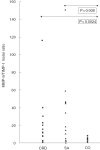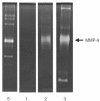Induced sputum-retrieved matrix metalloproteinase 9 and tissue metalloproteinase inhibitor 1 in granulomatous diseases
- PMID: 12390324
- PMCID: PMC1906521
- DOI: 10.1046/j.1365-2249.2002.t01-1-02001.x
Induced sputum-retrieved matrix metalloproteinase 9 and tissue metalloproteinase inhibitor 1 in granulomatous diseases
Abstract
Matrix metalloproteinases (MMPs) capable of degrading various components of connective tissue matrices, and tissue inhibitor metalloproteinases (TIMPs) are considered important in lung parenchymal remodeling and repair processes in pulmonary diseases. Induced sputum (IS) is a reliable noninvasive method to investigate pathogenesis, pathophysiology and treatment of lung disease. This study was designed to determine whether IS-MMP9/TIMP1 levels demonstrate lung parenchymal remodeling in sarcoidosis (SA) and Crohn's disease (CRD) patients. Sputum was induced and processed conventionally in 13 SA patients, 18 CRD patients and 9 controls. Two-hundred cells were counted on Giemsa-stained cytopreps, and T lymphocytes subsets (CD4 = T helper and CD8 = T suppressor cytotoxic cells) were analysed by FACS using monoclonal antibodies.MMP-9 and TIMP-1 were measured using commercial ELISA kits. MMP-9 concentrations, but not those of TIMP-1, were significantly greater in the sputum supernatant in SA and CRD patients compared to controls (P = 0.018 and P = 0.0019, respectively). The molar ratio, MMP-9/TIMP-1, was significantly higher in SA and CRD patients compared to controls (P = 0.008 and P = 0.024, respectively). Gelatinase species having a molecular weight similar to that of MMP-9 were demonstrated by zymographic analysis. MMP-9 levels were highly correlated with the CD4/CD8 ratio and DLCO capacity in SA but less in CRD patients. MMP-9 levels in IS provide a sensitive marker for pulmonary damage.
Figures

 Controls. Eos, eosinophils; Mast, metachromatic cells; Lymph, lymphocytes; Mac, macrophages; neut, neutrophils.
Controls. Eos, eosinophils; Mast, metachromatic cells; Lymph, lymphocytes; Mac, macrophages; neut, neutrophils.




References
-
- Hotermans G, Benard A. Nongranulomatous interstitial lung disease in Crohn's disease. Eur Respir J. 1996;9:380–8. - PubMed
-
- Fellermann K, Stahl M, Dahlhoff K, et al. Crohn's disease and sarcoidosis: systemic granulomatosis? Eur J Gastroenterol Hepatol. 1997;9:1121–4. - PubMed
-
- Lamblin C, Copin M, Billaut C. Acute respiratory failure due to tracheobronchial involvement in Crohn's disease. Eur Respir J. 1996;9:2176–8. - PubMed
-
- Johard U, Berlin M, Eklund A. Sarcoidosis and regional enteritis in two patients. Sarcoidosis Vasc Diffuse Lung Dis. 1996;13:50–3. - PubMed
MeSH terms
Substances
LinkOut - more resources
Full Text Sources
Medical
Research Materials
Miscellaneous

